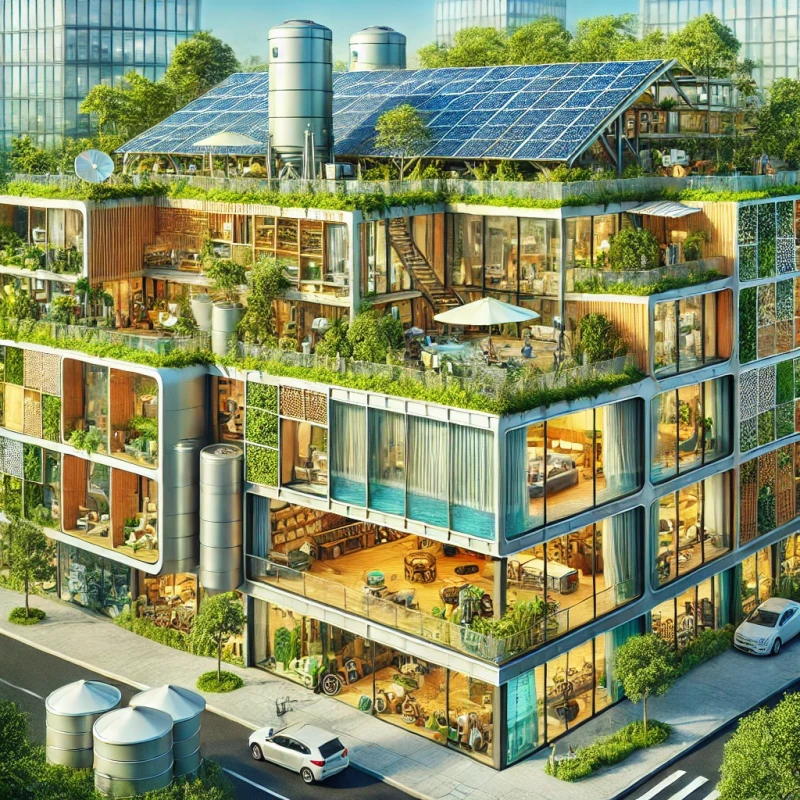- Dec 25, 2024
-
What is a Green Building?
Green buildings are reshaping the way we think about construction and sustainability. They're not just about innovative designs or energy-efficient structures—they symbolize a step toward a healthier planet and a sustainable future. In this blog, we’ll dive into what green buildings are, their defining features, benefits, and why they’re crucial for the environment and humanity.
What is a Green Building?
In simple terms, a green building is a structure that minimizes its negative impact on the environment throughout its lifecycle—design, construction, operation, and demolition. These buildings incorporate sustainable practices such as energy efficiency, water conservation, and the use of eco-friendly materials. The ultimate goal? To create spaces that promote human well-being while preserving the planet’s natural resources.
Key Characteristics of a Green Building
Green buildings stand out due to their focus on sustainability, resource efficiency, and environmental impact. Here are some defining features:
Energy Efficiency
- Utilizes renewable energy sources like solar or wind power.
- Employs energy-efficient appliances and LED lighting systems.
- Incorporates smart technologies such as automated lighting and heating systems.
Water Conservation
- Includes rainwater harvesting systems.
- Installs low-flow fixtures and water recycling mechanisms.
Sustainable Materials
- Uses materials like bamboo, recycled steel, or reclaimed wood.
- Reduces reliance on non-renewable resources.
Indoor Air Quality
- Ensures proper ventilation and air filtration systems.
- Avoids the use of toxic paints or materials with high VOC (volatile organic compound) emissions.
Waste Management
- Promotes recycling during construction and daily operations.
- Reduces construction debris by repurposing materials.
Location and Design
- Chooses locations that reduce urban sprawl.
- Designs that maximize natural light and ventilation.
The Benefits of Green Buildings
Why should we care about green buildings? The advantages go beyond the environmental impact—they also contribute to better health, financial savings, and global sustainability goals.
Environmental Benefits
- Reduces Carbon Footprint: By relying on renewable energy and efficient systems, green buildings significantly lower greenhouse gas emissions.
- Preserves Natural Resources: Encourages responsible use of water, energy, and materials.
Economic Benefits
- Cost Savings: While initial construction might be slightly higher, the long-term savings on energy, water, and maintenance costs make it a smart investment.
- Higher Property Value: Green-certified buildings often have better resale value due to their modern, sustainable appeal.
Health and Well-Being
- Improved Air Quality: Cleaner indoor environments reduce respiratory illnesses.
- Enhanced Comfort: Natural light and better ventilation improve mental health and productivity.
How Can You Incorporate Green Building Practices?
If you’re inspired to make your home or workplace more sustainable, here are some simple steps to get started:
- Install solar panels for renewable energy.
- Use energy-efficient appliances and lighting.
- Opt for eco-friendly construction materials like bamboo, cork, or recycled steel.
- Implement rainwater harvesting systems to conserve water.
- Prioritize proper insulation to minimize energy wastage.
Why Green Buildings Matter for Our Future
The construction industry is responsible for a significant portion of global energy consumption and carbon emissions. Transitioning to green building practices is essential to address climate change, protect biodiversity, and ensure a sustainable future for the next generations.
With increasing global awareness, green certifications like LEED (Leadership in Energy and Environmental Design) and BREEAM (Building Research Establishment Environmental Assessment Method) are encouraging developers and homeowners to adopt sustainable construction practices.
FAQs About Green Buildings
1. Are green buildings expensive to construct?
While initial costs may be higher due to the use of advanced technologies and sustainable materials, the long-term savings in energy, water, and maintenance often outweigh these costs.
2. How does a green building impact health?
Green buildings promote better indoor air quality, natural lighting, and ventilation, which reduces stress, respiratory issues, and other health concerns.
3. What certifications ensure a building is green?
Popular certifications include LEED, BREEAM, and WELL. These programs assess the sustainability and efficiency of buildings.
4. Can existing buildings be converted into green buildings?
Yes! Retrofitting existing structures with renewable energy sources, better insulation, and water-saving systems can make them more eco-friendly.
Final Thoughts
Green buildings are not just a trend; they’re a necessity in today’s world. By adopting eco-friendly construction practices, we can reduce our environmental impact, save costs, and improve our quality of life. The movement towards green architecture is more than a choice—it's a commitment to the planet and future generations.
Embracing green building principles is the way to go. After all, the greener the building, the brighter the future!


Comments :
Currently, there are no comments in this post. Be the first person to comment on this post.